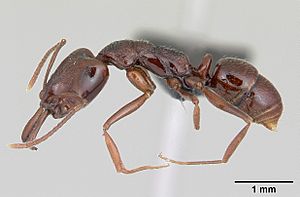Anochetus pattersoni facts for kids
Quick facts for kids Anochetus pattersoni |
|
|---|---|
 |
|
| Scientific classification | |
| Kingdom: | |
| Phylum: | |
| Class: | |
| Family: | |
| Genus: |
Anochetus
|
| Species: |
A. pattersoni
Fisher, B. L. & Smith, M. A., 2008
|
| Binomial name | |
| Anochetus pattersoni Fisher, B. L. & Smith, M. A., 2008
|
|
Anochetus pattersoni is a special kind of ant. It belongs to a group of ants known for their amazing "trap-jaws." These ants are part of the Anochetus genus.
Contents
What is Anochetus pattersoni?
Anochetus pattersoni is a fascinating insect. Like all ants, it is a social animal. This means it lives in colonies with many other ants. Each ant has a specific job to help the colony survive.
The Amazing Trap-Jaws
Ants in the Anochetus group, including Anochetus pattersoni, have unique jaws. These jaws can snap shut incredibly fast. They work like a spring-loaded trap. This special ability helps them catch their prey.
How Ants Are Classified
Scientists classify living things into groups. Anochetus pattersoni fits into these categories:
- Kingdom: Animalia (all animals)
- Phylum: Arthropoda (animals with exoskeletons, like insects and spiders)
- Class: Insecta (insects, with six legs and three body parts)
- Family: Formicidae (all ants)
- Genus: Anochetus (the group of trap-jaw ants)
- Species: A. pattersoni (this specific type of ant)
Where Do These Ants Live?
Anochetus pattersoni was first found in the Seychelles. The Seychelles is a group of islands in the Indian Ocean. These islands are known for their beautiful tropical forests.
Tropical Island Homes
Ants like Anochetus pattersoni often live in warm, humid places. They can be found in the leaf litter on the forest floor. This is where they hunt for food and build their nests. The rich environment of tropical islands provides many resources for these ants.
What Do Trap-Jaw Ants Eat?
Anochetus pattersoni ants are predators. They use their powerful trap-jaws to hunt. Their diet mainly consists of small insects and other tiny creatures.
Hunting with Jaws
When a trap-jaw ant finds prey, it opens its jaws wide. It holds them ready to snap. When the prey gets close enough, the jaws close with incredible speed. This stuns or kills the prey. The ant then carries its meal back to the colony.
How Were They Discovered?
This ant species was discovered on December 19, 2005. The person who found it was S.M. Goodman. Finding new species is an important part of science. It helps us understand the amazing variety of life on Earth.
Describing New Species
After the ant was found, scientists studied it carefully. Fisher, B. L. & Smith, M. A. officially described this species in 2008. When scientists "describe" a species, they give it a formal name. They also write down all its unique features. This helps other scientists identify it in the future.
See Also

